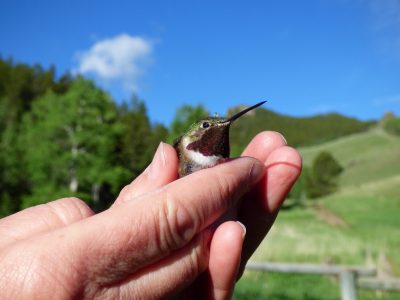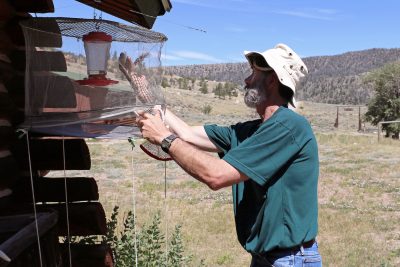Hummingbirds have long held a deep fascination with the public, whether being observed hovering and flitting their wings at amazing speeds around bird feeders or admired as symbols of love and peace.
On a practical level, hummingbirds devour hundreds of flying insects each day, including mosquitoes, and provide pollination for reproduction of flowers and plants.
However, this important bird species is in decline worldwide, and a University of Wyoming researcher delved into the reasons—as well as possible ways to preserve hummingbirds in the future.

“I wrote this review paper, with collaborators’ help, to provide a summary of current understanding of population health, disease ecology, and genomics as they relate to hummingbirds,” says Holly Ernest, a UW professor emeritus of wildlife genomics and disease ecology, who retired in 2022 as Wyoming Excellence Chair in Disease Ecology in the Department of Veterinary Sciences and as mentoring professor in the Program in Ecology and Evolution. “We appraised knowledge gaps; causes of morbidity and mortality, including disease; and threats to population viability. Finally, we highlighted areas of research need and provided ideas for future studies aimed at facilitating hummingbird conservation.”
Ernest was the corresponding and co-first author of a paper titled “Illuminating the Mysteries of the Smallest Birds: Hummingbird Population Health, Disease Ecology and Genomics” that was published on Feb. 15 in the Annual Review of Animal Biosciences. The journal places a particular emphasis on biotechnology, genetics, genomics and breeding, as well as veterinary medicine, especially veterinary pathobiology, infectious diseases and vaccine development, and conservation and zoo biology.
Hummingbirds are a group of birds with the second-highest numbers of species worldwide, ranking only behind flycatchers. Most species are found in South America and Central America, with the core of hummingbird biodiversity in Ecuador and surrounding countries, Ernest says.
The International Union for Conservation of Nature’s Red List of Threatened Species includes 191 hummingbird species as having decreasing population trends and 71 other hummingbird species with “unknown” trends as of July 2023, according to the paper. Two Caribbean hummingbird species are listed as extinct, and other species likely were never identified to written science before their extinction, the paper says.
During the summer, three species of hummingbirds regularly breed in Wyoming, Ernest says. One species is the broad-tailed hummingbird, which is seen in the highest numbers in the state. In the higher elevations of mountains, calliope hummingbirds breed. They are the smallest bird in the continental Americas, weighing as little as 2.5 grams, or half the weight of a U.S. nickel. Near streams and rivers, black-chinned hummingbirds are occasionally seen in Wyoming.
Additionally, rufous hummingbirds commonly visit Wyoming feeders as they migrate to breeding areas farther north into Montana and western Canada, she says.
Despite the apparent visual cues of several hummingbird species seen at feeders in suburban neighborhoods in North America, a wide range of hazards and threats have caused many hummingbird populations to decline.
These hazards include climate change, wildfires, habitat degradation and loss, and exposure to toxins and nonnative predators, including outdoor cats, and vary by species and ecosystem, Ernest says.
“Climate change affects them in a number of ways that we know about and probably many more that we don’t,” Ernest says. “One example is a mismatch of migration timing with plant flowering that hummingbirds depend on. Another example is the effect of changing climate with invertebrate communities, including insects that hummingbirds need for their protein source.”
- Predatory outdoor cats, as well as domestic cats, kill a lot of birds, including hummingbirds. Ernest suggests that pet owners keep their cats inside, if possible.
- High-rise buildings, especially those with glass, kill hundreds of thousands of birds globally every year, including hummingbirds. Most of the birds killed occur during migration periods, Ernest says. Experts from the National Audubon Society and the Cornell Lab of Ornithology suggest a number of easy ways to reduce birds from hitting windows at home and also installing special bird-safe types of glass at time of construction or renovation.
- Loss, fragmentation and pollution of hummingbird habitats are other concerns.
“Some hummingbird species are generalists in that they sip nectar from all flowers, but many are specialists, even to one or a few species of flowering plants,” Ernest says. “If those plants disappear, so do the hummingbirds. Air, land, and water pollution is a problem in many ways, including the intersecting threat of large wildfires.”
These physiological stressors and exposures exacerbate disease risk, which can threaten population viability, Ernest adds.
According to the paper, hummingbird conservation is hindered by knowledge gaps in population biology parameters, including vital rates, population sizes, genetics, normal physiology versus stress physiology, disease prevalence, habitat requirement, and ecosystems status.

However, there are some study methods that can be useful in determining the best direction for the future conservation of hummingbirds, the paper says.
For example, bird leg banding, used to collect data and samples, has been an important research tool for studying hummingbird disease ecology and genomics. In North America, bird banding data have allowed researchers to assess sex-specific prevalence of diseases; rates of species hybridization; longevity; and migration ecology, according to the paper.
Additionally, radio telemetry studies are used for locating and tracking movements of hummingbirds. The miniaturization of radio transmitters has allowed for expanded use with less impacts on hummingbirds’ flight and behavior, the paper says. Previous radio telemetry studies have been able to assess the effect of tropical deforestation on hummingbirds’ landscape movement patterns; patterns of habitat use; hummingbird interactions with nectar-producing plants; and migration ecology.
And genomic science has created opportunities for studying the epidemiology of pathogens and a better understanding of disease ecology in hummingbirds. Avipoxvirus — wart-like growths on feather-free areas of the skin — is one example that can be studied in more detail, according to the paper.
Lisa Tell, a professor of veterinary medicine at the University of California-Davis, was the paper’s co-first author. Other contributors were Emily Lumsdaine, who was a master’s student in avian science at the University of California-Davis during the time of the research; Ana Gonzalez, an ornithologist originally from Colombia, and Christine Bishop, a research scientist emeritus, both from Environment and Climate Change Canada, a government agency in British Columbia.
The paper reviewed key scientific findings over the past 100 years. Ernest says she started conducting literature research, along with her co-authors, in 2007 when she started hummingbird research in California. Ernest moved her wildlife disease ecology and genomics lab and hummingbird research to UW in 2014. She then invited co-authors with expertise in hummingbirds—from South America to Canada—to help provide ideas for the review paper. A comprehensive review of the literature began in early 2022, with the paper completed in October 2023.
“I was honored to be invited to write this paper, and it is a wonderful capstone to the hummingbird health and conservation parts of my career,” Ernest says. “It was a great opportunity to reconnect with hummingbird research and conservation colleagues as I asked for help with the paper.”
Although now retired from UW, Ernest says she is currently working as a consultant and as a volunteer for the conservation of wildlife and the natural systems on which animals and people rely. To read about her work at UW and the University of California, as well as current projects, go to www.wildlifegenetichealth.org.
“I continue working to better understand and educate the public of the biology of hummingbirds and wildlife, in general, and their conservation, as well as a new focus on coastal near-shore marine habitats and wildlife of the Pacific Northwest,” she says.
This story was originally published on UW News.




